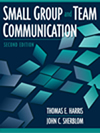 |
 |
 |
 |
![]()
Volume 6,
Issue 1,
Fall 2002
|
Small Group and Team Communication Harris, Thomas E., Sherblom, John C.Allyn & Bacon, 2002 335 pages Paper: US $55.00 |

|
Reviewed by: John
McGrath, Trinity University
Printer-friendly PDF
version
The inclusion of the word “Team” in the title of this textbook boldly distinguishes it from other textbooks on Small Group Communication. The title reflects a pragmatic approach incorporating organizational and management literature, where there has been considerable interest in self-managed teams and in the topic of teamwork in general.
This multidisciplinary text suggests that we have a lot in common and should listen to each other, but the book could make a stronger contribution by revealing the connections among disciplines. Researchers in communication and researchers in management (and other fields) often exist on separate academic planes and in states of disciplinary isolation. The authors miss an opportunity to address the relationship between groups and teams, which seems appropriate for the introduction or first chapter. It would be helpful to describe how the terms have been used differently; or, if the authors are suggesting they are synonymous, a case supporting that claim should be made.
The primary strengths of this text are the topics that help differentiate it. The chapters on teams, diversity, creativity, and computer mediated group communication reflect recent trends in small group research and are very well done. The chapter on “teams” draws heavily from the management literature and gives convincing examples of how teams play a prominent role in contemporary American business. The authors also explain how diversity in groups should be thought of as a fundamental strength, and how showing sensitivity to individual differences is an important part of being an effective, competent communicator.
An entire chapter devoted to creativity is a bit unusual for a small group text, but given the increasingly complex social world we live in, attention to harnessing the power that groups have to offer in terms of creative problem solving seems on-target. For instructors who have not spent much time on creativity in the past, the chapter provides an opportunity to offer a new and meaningful unit on a topic that is fun and interesting.
The computer mediated communication (CMC) chapter introduces the reader to an impressive variety of technologies that are now being utilized in small groups. The authors balance their enthusiasm for the advantages and possibilities of CMC with an excellent discussion of the pitfalls of losing face-to-face cues and the impact of technology on human relationships.
Chapter topics that are a bit more typical for a small group text include the following: systems theory, norms, roles, phases, nonverbal communication, listening, decision-making, conflict, and leadership. Coverage of these essential areas is strong, and the writing is clear and straightforward. All of the chapters begin with a thought-provoking quotation or vignette that helps introduce topics and ties the material to real-world situations. Each chapter also includes well-phrased discussion questions and a variety of exercises and activities.
The text is addressed to students who have not necessarily had other coursework in communication, and thus may seem too basic or repetitive for juniors and seniors who are communication majors. For example, the material on listening and nonverbal communication is very close to what students might cover in an introductory speech course or a course in interpersonal communication. For upper-level students, the familiar topics need more depth and require updated examples of small group research. On the other hand, this book could serve as a very good text for a lower division course populated by a variety of majors; or possibly as a supplemental book in a business communication course.
Back to Top
Home | Current
Issue | Archives | Editorial
Information | Search | Interact